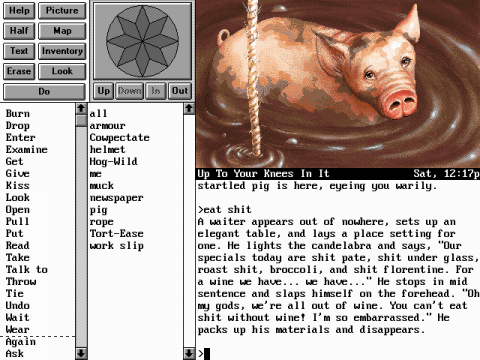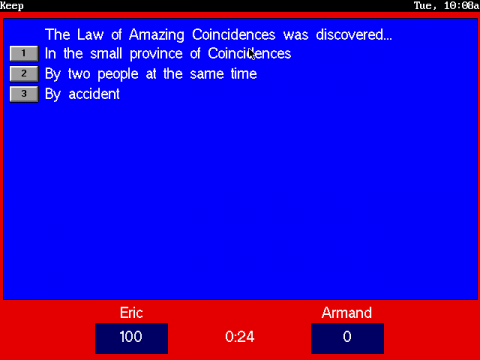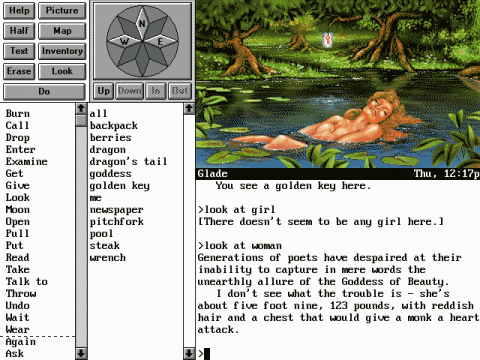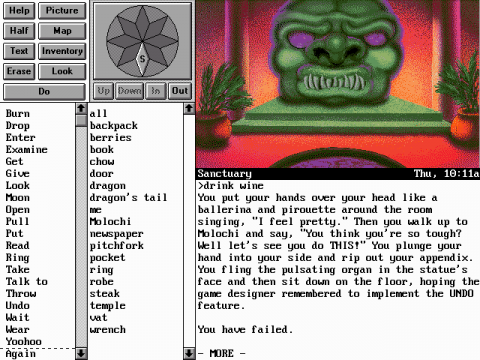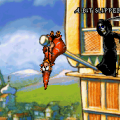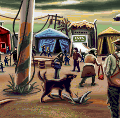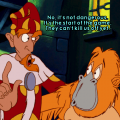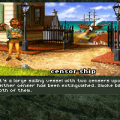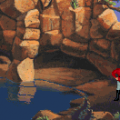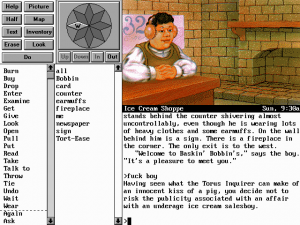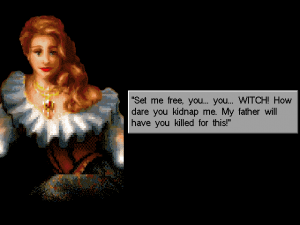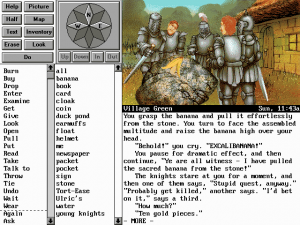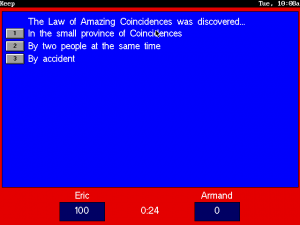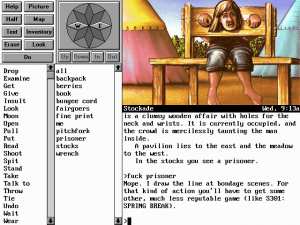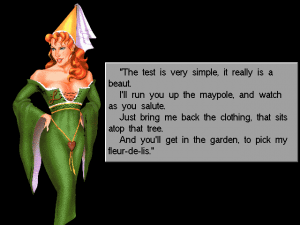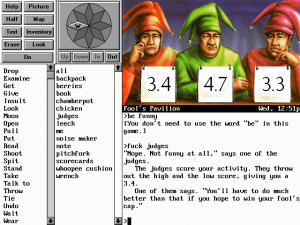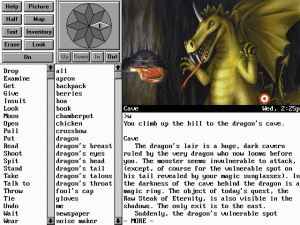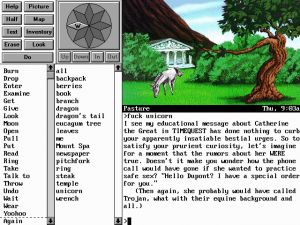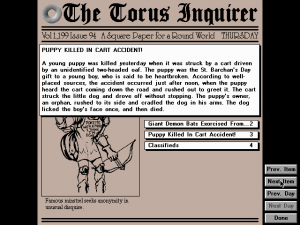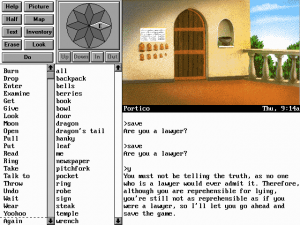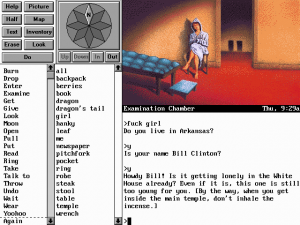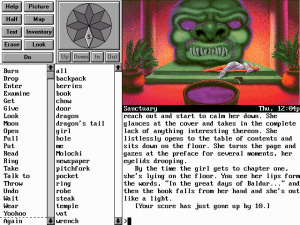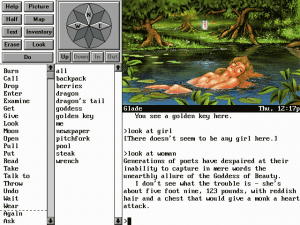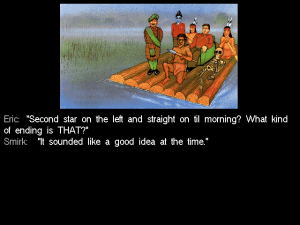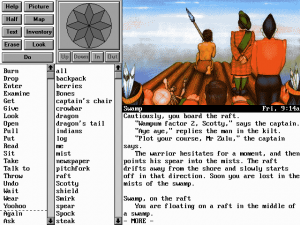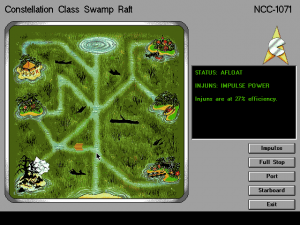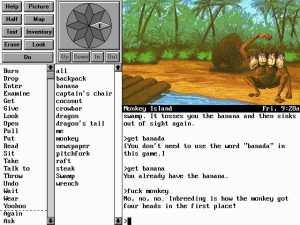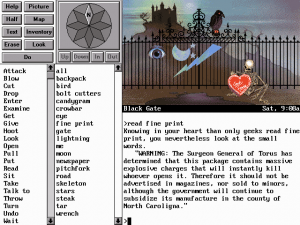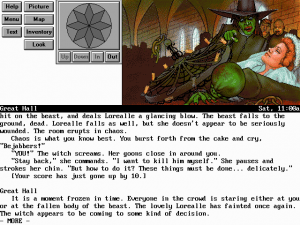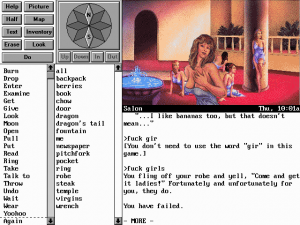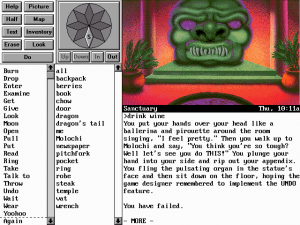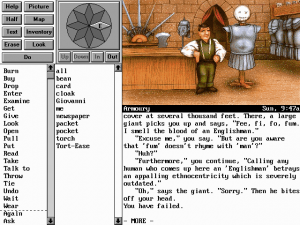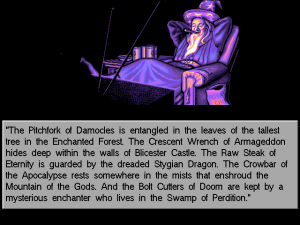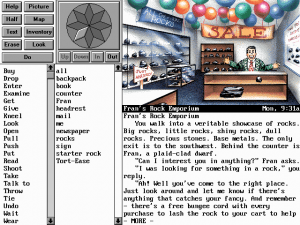It’s easy to admire Legend Entertainment, simply for fighting the good fight. The purchase of Infocom by Activision in 1989 was essentially a death knell for text adventures, as the company clearly had no idea what to do with it, other than some awful “interactive comics”, a few semi-relevant Zork games, and sticking the label in places it didn’t really belong, like their localization of the NES game Tombs & Treasures. Despite losing traction against visual adventure games from the likes of Lucasarts and Sierra, Legend believed that there was still an audience for interactive fiction, and hung tightly to ideal, for at least a few more years.
Eric the Unready was one of the last text adventures produced by the studio, before they too ditched the keyboard parser in favor of a more direct interactive. It’s the tale of a foolhardy knight that brings a “HOW TO JOUST” book to his first battle with a rather ominous foe. Eric defeats him, by accident, and somehow ends up earning the respect of the knight’s guild. Still, his ineptitude has given him the reputation of a buffoon amongst his peers. That doesn’t stop him from being ordered on a quest to retrieve five mystical artifacts – the Pitchfork of Damocles, the Crescent Wrench of Armageddon, the Raw Steak of Eternity, the Crowbar of the Apocalypse, and the Bolt Cutters of Doom. All of these items are necessary to defeat an evil witch, who is involved in a sinister plot to marry off the real princess and give control to the insidious Queen Grizelda, who wishes to turn the kingdom into a giant strip mall.
The game is divided into seven chapters – the intro, one chapter for each of the items, and then the finale. After the end of each chapter, Eric is comically thrown from one area to the next, causing him to lose any unnecessary items, keeping your inventory slim. It’s impossible to revisit past locations, but there’s never really a case where you can get stuck without the proper items, except for one spot near the end. Even then, the most you have backtrack is the beginning of the final chapter. There are a handful of spots where you can die (usually in amusing fashions – try eating some magic beans to have a beanstalk explode out of your arse), you can undo any action, so rampant saving isn’t necessary. Most text adventure veterans seem to consider the puzzles to be pretty easy, but anyone accustomed to point and click adventures will find it substantially more difficult. Many of them require following the game’s bizarre sense of logic, but most are clever and humorous.
For example, at the beginning of the game, you need to get past a group of guards. In the towns square is a bard who, upon command, will recite the epic poem of Baldur, which will put anyone in the area to sleep out of sheer boredom. To solve this, you need to grab a pair of earmuffs from a kid, wear them and get the bard to recite the poem. You’ll be invincible to its effects, and the bard will follow you out of respect. So, walk to the guards, get the bard to tell the story again, and voila! They, too, will collapse, allowing you to progress.
The game is also loaded with spoofs of pop culture. The first step on your quest requires entry to a kingdom suspiciously like the beginning screen of Zork, complete with a mailbox. Here, you’ll meet an overly enthusiastic rock salesman, and disguise yourself as a height-challenged dwarf (HINT: Just wear a beard and type “kneel”, they can’t tell the difference.) The next chapter has you defeating a group of ravenous attack turtles through the use of a muscle relaxant (“Tort-Ease”, hohoho) and then playing an impromptu game of Jeopardy against a Frenchman based on the largely nonsensical history of the kingdom. Then you disguise yourself as a vestal virgin and purposely sacrifice yourself to a silly looking idol, only to bumble into the Land of the Gods, a place ruled by a rather inept bureaucrat. One chapter, affectionately referred to as “Swamp Trek” features Eric piloting a raft with a crew suspiciously based off the famous sci-fi TV series – they even join you after you show them some “rodenberries”. The paddles are controlled by Indians, paving the way for “Injuns working at 87%!” and other such jokes. During this segment, you come across Phantasy Island, where you’re greeted a Ricardo Montalban-style character, who then morphs into “Kahn” (complete with the appropriate outfit) and takes the rest of your crew prisoner. In the final segment, you’re captured by the evil witch and imprisoned. She puts a curse on you – when the sands of the hourglass run out, you’ll die. The solution? Just tip the hourglass on its side.
It’s clear that Eric the Unready is at least somewhat inspired by Monty Python and the Holy Grail – there are more than a few direct allusions to it – and while it shares in the British troupe’s style of absurdist humor, it has its own unique voice too. There’s obviously a lot of pop culture references, and plenty of completely random situations that come out of left field. Like Steve Meretezky’s Spellcasting series, another Legend title, Eric the Unready has a lot of fourth wall breaking commentary, usually when you try to do stupid things with the text parser. Like all great humor games, the events of actual quest are funny enough, but the true gems lie in mucking around with everything. This is one of the very few games where you can type “fuck ____” at every person and actually get a unique response. Leisure Suit Larry gave you the zipper icon, and yet the responses usually weren’t as funny as you’d think. (And besides, you were supposed to get it on with everything in those games.) You can even type it for inanimate objects and get the response “OK, press Space when you’re finished having your way with the _____”.
At the beginning of each chapter, you find a newspaper which recaps Eric’s exploits in the previous section in a tabloid style. Since the game is all first-person, and Eric is merely a cypher for the player, the hero doesn’t have much of a personality of his own, but it’s cool to look on previous events (like when you have to perform a ritual by dressing up like a chicken, eating an insect and spinning around, only to be politely informed by a passerby that said ritual is long outdated and provides a much less humiliating solution) and see them commented on. At one point, you need to distract a two-headed ogre by giving them some beer. In the next chapter, you learn that the ogre got into an accident and ended up killing a puppy. That’s actually pretty funny, in a sad way – adventure games are usually full of amoral activities and it’s weird to see the negative effects of your selfish actions. In addition to giving hints, it’s also full of goofy personal ads from various real life figures. One of the best:
Lost: All sense of proportion and decency. – Madonna
Like all of Legend’s text adventures, the screen is broken up into several sections and looks a bit like Windows 3.1, despite running in DOS. On the left side are columns which contain all available verbs, prepositions and nouns, including everything in the area and in your inventory. The upper left portion of the screen shows a compass showing all available exits, as well as a few different options. The upper right portion of the screen shows a small graphic of the area, but can be changed to a map or list of your inventory. Honestly, while it’s nice to have visuals to accompany the text… they really aren’t very good. They’re fairly generic and don’t really express much of the humor that comes from the text. In fact, it’s generally only useful when the text makes fun of it, at one point commenting on how a particularly stupid looking elf has ears that look like hotdogs stapled to the side of his head. Still, they don’t look too bad considering they’re drawn with only 16 colors. The cover artwork was also provided by prominent fantasy illustrator Boris Vallejo, and it would’ve been cool to see the whole game in this style. The interface is pretty messy, but you can disable the word columns so at least the text fills the bottom two-thirds of the screen, making it much easier to read. There’s some light MIDI music which occasionally changes as you move areas, although none of it’s particularly memorable. Although the game was distributed on both floppy disk and CD formats, the versions are identical, as there’s no fancy audio or voice acting.
There are a few mini-games and brief sections where the game breaks away from the standard text entry, particularly when you talk to someone. The interface fades away and just gives you a series of dialogue choices to pick from. It does make character interaction much easier than normal, even though these segments are often the weakest point of the game, humor wise. The situations are generally much more amusing than the dialogue.
Eric the Unready has a lot going for it. Despite being one of the most outright funniest adventure games ever made, it tends to be cast aside from the usual classics like Monkey Island and Space Quest, perhaps because point and click fans would rather shuttle it off into the “interactive fiction” ghetto, reserved solely for the oldest of old school fans. Perhaps the game would’ve received greater accolades if it more closely mimicked LucasArts adventures, but it would also remove a lot the flavor text which makes the game so funny. As it stands, it’s still classic in every regard.


